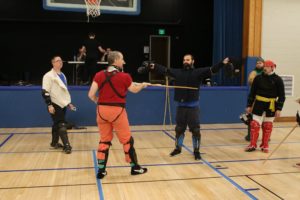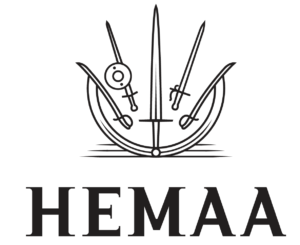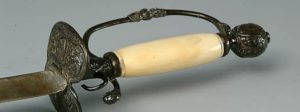Judging
Judging is probably the most contentious aspect of any event – so we’re largely going to do away it!
- Fencers are expected to call hits against themselves (holds true for ALL events)
- Bouts will be managed by at least two ‘Seconds’ who will:
- Start and stop the action of the bout
- Watch for unsafe conditions/behaviors
- Watch for uncalled hits – each Second will watch for hits on ONE fencer
- Seconds will determine the timing of the afterblow, where applicable
- Poll the fencers about Skill/Art points
- Report the results to tournament staff
- Seconds have the authority to award points in the event of uncalled hits and/or rule infractions as well as settle disputes between the two fencers (the “I hit you First” issues)
- ALL Fencers are expected to serve as Seconds throughout the weekend
NOTE: For the Dueling Saber event we will be bringing in MOF judges who are familiar with priority rules to serve as directors.
Brass Frog AoA General Rules
- Use of excessive or brutal force is strictly forbidden. The first offense will result in a warning. The second (IN ANY FUTURE BOUT) will result in a loss of the bout. Subsequent offenses and any offense resulting in an injury where the injured fencer is no longer able to compete will result in ejection from the event, at the discretion of the judges and tournament staff.
- Prior to the start of any exchange the judging staff will ask if fencers are ready. The exchange will start when the judge calls “Fence!” The exchange will end when the judge calls “Halt!” Upon the called halt fencers must cease any aggressive actions and return to the appropriate side of the ring/piste.
- Bouts are to be conducted for a maximum of three minutes. Point limits vary by weapon event.
- Fencers are expected to call hits against themselves (holds true for ALL events)
- All attacks must be made while fully in control of the attacking fencers motion to be valid. Uncontrolled attacks may be considered as excessive or brutal force at the discretion of the judges and tournament staff.
- Thrusts (where allowed) – thrusts must land point-first on target. Thrusts to the mask should be pulled to avoid injury.
- Cuts (NOT smallsword) – cuts can be made with the true or the first third of the false edge. Cuts made with the flat are not valid, but will cause a halt to be called. Cuts made with the strong of the blade will be considered as excessive force.
- Slices (NOT smallsword) – slices can be made with a push or pull of the blade to the arms or head and must be of sufficient force
- The back of the head is not a valid target in any event
- Disarms and dropped weapons are scored as a point for the fencer retaining his/her weapon.
- Leaving the ring/piste for any reason will result in a point for the opponent.
- Pommel strikes, punches, kicks, elbow and knee strikes are not allowed
- Grappling is not allowed.
- Ignoring the directions of the judges or arguing with the judges will result first in a warning. Subsequent offenses (in any bout) will result in points being granted to the opposing fencer or loss of the bout.
Team Event
In this event, teams of three fencers compete in a relay match with cumulative scoring where every fencer competes against every other fencer in a series of nine “legs,” or bouts. The first team to score 45 points (or the team leading when time expires) is the winner.
The team event is essentially a race to a point target. The target increases by five in each of the nine “legs,” or one-on-one bouts within the larger team match.
The target scores are:
Leg/bout 1: 5
Leg/bout 2: 10
Leg/bout 3: 15
Leg/bout 4: 20
Leg/bout 5: 25
Leg/bout 6: 30
Leg/bout 7: 35
Leg/bout 8: 40
Leg/bout 9: 45
Each leg can end in one of two ways:
*Either team reaches the target score for that bout
*The 3-minute time expires for that round
- Each “leg” (bout) of the relay match consists of five touches (5, 10, 15, 20, etc.); the maximum time for each bout is 3 minutes.
- The first two opponents fence until one of them has scored five touches, within the time limit of 3 minutes.
- The next two opponents fence until one of their scores has reached ten touches, within the time limit of 3 minutes, and so on with successive bouts, cumulatively, of five touches.
- If by the expiration of 3 minutes of fencing time the intended score for the bout has not been achieved, the next two fencers take up the score where it was left off and fence up to the maximum score intended for their bout as normal, within the time limit of 3 minutes.
- The winning team is that which first reaches the maximum score of 45 touches, or that which has scored the greatest number of touches after the expiration of regulation time.
- If at the end of regulation time for the last bout the scores are equal, the match continues for a deciding touch, with a maximum time limit of one minute, fought for by the fencers of the last bout in the match. Before the fencing recommences the Director draws lots to decide who will be the winner if scores are still equal at the end of the extra minute.
Smallsword
This year’s smallsword tournament is modeled after dueling conventions in mid-19th century Germany.
- Format will be multiple rounds of pools, leading to a final pool of 6.
- Duelists will stand with their front foot behind lines set approximately at lunge distance apart. Seconds will stand at the side of each fencer (see Seconds’ responsibility for more information.)
- Duels are to 3 points.
- Scoring:
- Thrust to the head or torso: 3
- Thrust to the arms: 1
- Crossing the opponent’s starting line: 1
- Disarm: 1
- Doubles will not be scored for either opponent and the pass will reset. If the fighters double 2 times, both fighters will be marked with a loss.
- Use of the offhand in parrying is permitted. Grabbing the opponent’s weapon or body is not permitted. A thrust that hits at hand during an attempted parry may be called as a thrust to the torso (stapling).
- There will be no afterblows; see second’s responsibility for more information.
- If a person surpasses 3 points, it is still just a win and there is no additional benefit.
- There is no time limit; the duel will continue until one opponent hits 3 points, or 2 doubles have occurred.
Second’s Responsibility: The second’s job is to watch for hits on the opponent. Once their fighter has hit the opponent, the second steps forward between the two fighters using their weapon to halt action. In a duel, this was to prevent the opponent from striking the fighter with an after-blow. For the first round of pools, each fighter will be paired with someone from the other set of pools so that everyone will have an opportunity to be a second (there are 8 pools, 4 going at once).
Dueling Saber
Use of the offhand in parrying or grabbing the opponent’s weapon or body is not permitted.
2. Unless a single fencer hits, only actions that arrive with priority are considered valid
- Priority is established when one fencer begins an attack, as indicated by threatening forward movement of the point or extension of the fencer’s arm.
- In the event of simultaneous actions, no fencer is given priority
- An attack which has failed (missed, fallen short or been parried) no longer holds priority
- The defending fencer can obtain priority by parrying and riposting, a single-time counter or stop-cut/thrust that closes the line, or in some way causes the initial attack to not land
- Breaking distance, causing the initial attack to fall short, and executing an attack
- A parry or single-time counter that is deemed insufficient does not gain priority for the defending fencer
- An insufficient parry/counter is one in which the initial attack still hits without changing the line of attack.
- Priority will be determined by the referee, who will call the action as well as poll the judges.
4. Bouts are to 3 points or 3 minutes
Skill/Art Points
We plan to recognize fencers who display a great deal of skill or art in their bouts, much as we we have done in past years. To accomplish this, fencers will be awarded points at the end of each bout and pool. At the end of each bout, 2 points may be awarded by the Seconds or Judges. At the end of each pool, fencers will be asked to identify the two fencers in their pool who they feel displayed the highest degree of Skill/Art in their fencing. At the end of each event the two fencers with the highest number of Skill/Art points will be awarded a ribbon that can be worn the remainder of the weekend while fencing.
Seconds/Judges and fencers should keep in mind the conventions of the weapon when awarding skill/art points.
Prizes
Plaques for 1st to 3rd place in each event will be awarded. Ribbons will be awarded to the two fencers with the highest number of skill/art points in each event. Gift certificates and prizes from our sponsors will be awarded to the fencers with the highest total number of skill/art points and the to the fencers with the highest average number of skill/art points per bout. Door prizes will also be given out over the weekend





